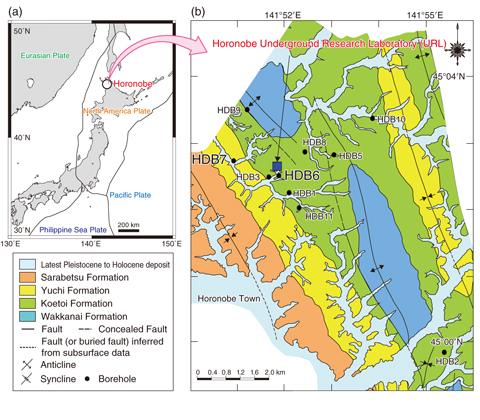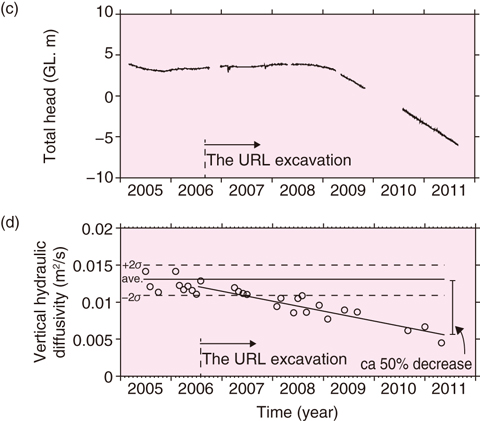
Fig.8-15 Maps showing the location of the Horonobe URL site and boreholes (a) location map and (b) geological map

Fig.8-16 (c) Total head and (d) time history of vertical hydraulic diffusivity
In the development of an underground research laboratory (URL), significant groundwater drain induced by excavation leads to decreases in groundwater pressure at the URL site. A possible reduction in the porosity of sedimentary rock owing to groundwater drainage is predicted during the excavation and operation of the URL, leading to permeability reduction. Although these changes are reversible processes, the observation of a porosity reduction has not yet been reported. In assessing the safety of geological disposal of HLW, rock permeability is an important factor when considering the migration of nuclides from the waste with groundwater flow. Research on permeability change and recovery will be helpful for future operations. In this report, a groundwater-pressure record observed at a point approximately 130 m distant from a URL was analyzed and a permeability-change history was obtained.
The Horonobe URL is located in northern Hokkaido (Fig.8-15(a)) in an area covered by thick sedimentary formations (Sarabetsu, Yuchi, Koetoi, and Wakkanai formations in Fig.8-15(b)). Among the groundwater-pressure records at several boreholes (HDB1 to HDB11), the permeability-change history of HDB6 is presented in this report.
The groundwater level in a confined well generally falls in response to an increase of the atmospheric pressure, and vice versa. The responses of groundwater (whether quick or slow and large or small) are related to the hydraulic properties of formations, which can be handled mathematically using a poroelastic theory that assumes that rock comprises porous and elastic material such as hard rubber with numerous openings filled with groundwater. Rock permeability can be obtained by analyzing the atmospheric response of groundwater pressure with the poroelastic theory.
In the analysis, monitoring records observed during the seven-year period from 2005 to 2011 (Fig.8-16(c)) were used. Long-term data obtained through continual observations for three months were used for the calculation as a single set, which provides the permeability-change history.
The results are shown in Fig.8-16(d). Hydraulic diffusivity, which is one of the parameters of rock permeability and proportional to the propagation rate of groundwater-pressure change in a rock mass, was approximately (1.2 ± 0.2) × 10−2 m2/s before URL excavation (before August 2006), whereas it decreased gradually from 2007–2008. Finally, it dropped to approximately (0.6 ± 0.2) × 10−2 m2/s in May 2011.
According to a published study, the permeability in mudstone generally fluctuates by more than two orders of magnitude. The reason for this fluctuation is that conventional hydraulic testing is affected by local fractures whose occurrences differ by location even in the same rock. The small decrease of approximately 50% is significant because it was obtained continuously at the same point, a situation that is different from that of a conventional hydraulic test.
This study revealed that the groundwater flow was reduced by the pressure decrease associated with URL excavation, although this influence is limited. Because the operational period of the HLW geological-disposal site will be several decades in the future, this investigation yields important suggestions for considering long-term groundwater flow.